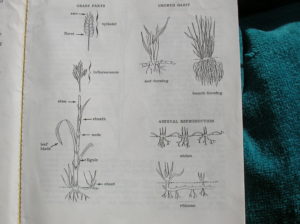Poachea (Grass)
The general importance of the grass family to the prairie and other notes.
 The grasses contribute most of the prairies plant biomass and provide fuel for prairie fires. Humus form the delay of their dee and extensive rood systems are mainly responsible for the rich, black color of grassland soils.
The grasses contribute most of the prairies plant biomass and provide fuel for prairie fires. Humus form the delay of their dee and extensive rood systems are mainly responsible for the rich, black color of grassland soils.
The growth habit of prairie grasses is sod-forming or bunch-forming, or both. Sod-forming grasses, such as cordgrass and witch grass, reproduce sexually from seed and asexually fro underground stems called rhizomes. The rhizomes extend horizontally from a few inched to a few feet to form the parent plant and produce new shoots from their tips from the nodes along the stem. This results in a dense strand of shoots that compactly occupy the soil. A few sod-forming grasses also reproduce from horizontal stems above the ground called stolons.
Bunching-forming grasses have an erect growth of shoots at their base. These shoots are called tillers. Little bluestem and prairie dropseed are bunch-forming grasses. Like sod-forming grasses, bunch-forming grasses reproduce sexually and asexually. Sometimes a grass species, such as big bluestem , may have son-forming and bunch-forming growth habitats.
Besides the taxonois classification, prairie grasses may be grouped according to their climatic origin as the cool-season or warm-season grasses. Cool-season grasses, such as needlegrass and bluejoint are of other origin They renew their growth in early spring and usually mature from April to early July. Cool-season greases become semi-dormant during the hot summer months and renew growth during autumn. By contrast, Warm Season grasses, such as big and little bluesteam, begin growth late spring and grow continuously during the summer and into early fall. They mature during mid-fall. Warm-Season and cool-season grasses mingle freely as their requirements overlap.
Grasse have several anatomical features which enable them to flourish in the relatively harsh environment of the prairie. Some of the anatomical feature include:
- The deep root system that reaches depths of 2-4 meters and branch profusely, enabling the grasses to obtain water during periods of drought.
- Tough steam reinforced buy silicon oxide, which enables the grasses to withstand high winds and
- Specialized hinges cells in the upper epidermis of the leaf. During periods of drought, they lose water rapidly, then contact and cause the leaf to roll up in the long tube. The pores thought which water vapor is normally transpired are now inside the tube, while the exposed lower surface of the leaf is highly resistant to water loss.
Many of these grasses provide eco-friendly and sustainable landscaping techniques. Many landscape designers are using natural prairie grasses to cut down on maintenance costs, improve the natural habitat for local wildlife, reduce soil erosion and reducing the use of herbicides and pesticides. To order
